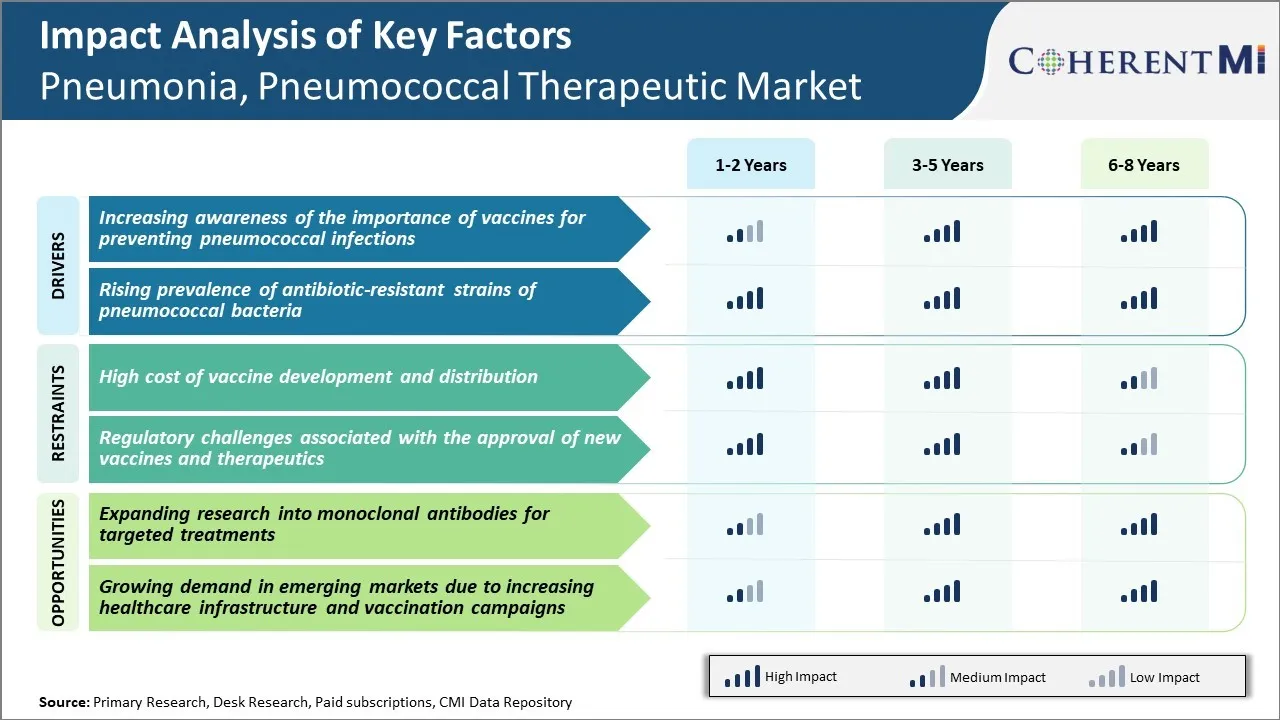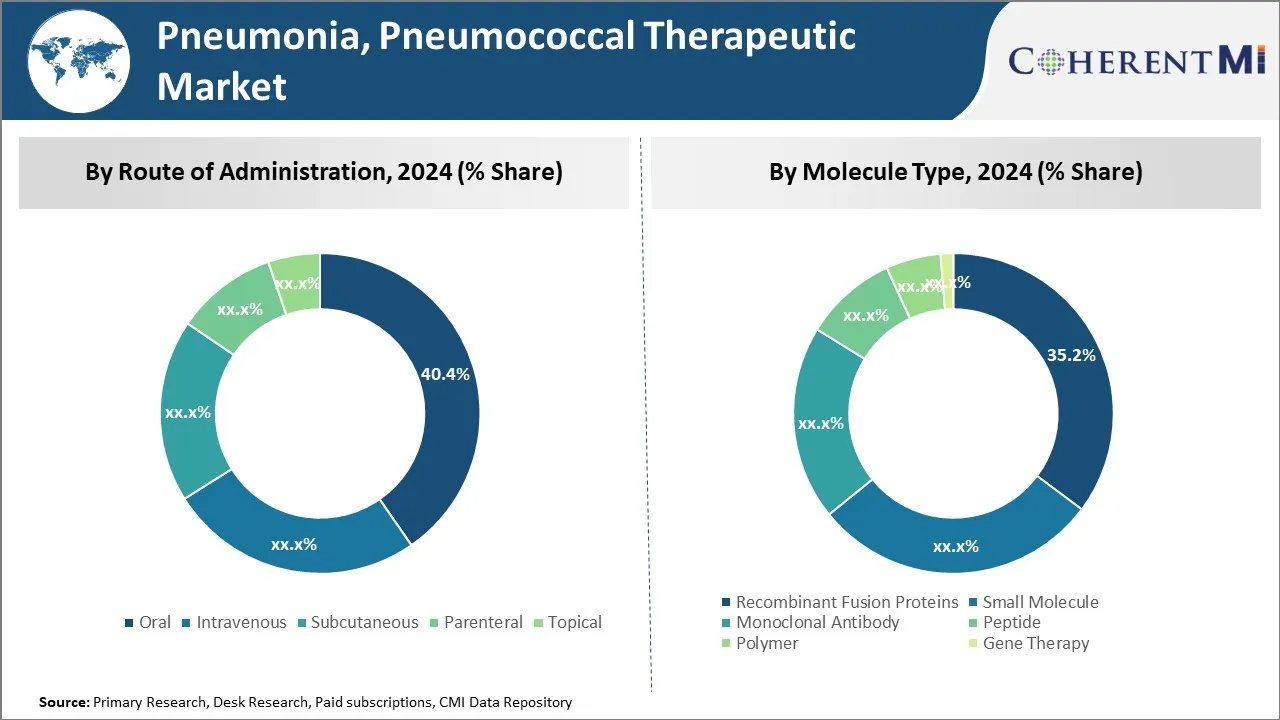肺炎、肺炎球菌治疗市场 规模与份额分析 - 成长趋势与预测 (2024 - 2031)
肺炎、肺球菌治疗市场按管理方式划分(Oral、Intravenous、Subcutaine、Purderal、Topical), 由分子类型(重组蛋白,小分子,单克隆抗体,Peptide Polymer,基因治疗),按地理(北美,拉丁美洲,亚太,欧洲,中东,非洲)分类. 本报告为上述部分提供了价值(....
肺炎、肺炎球菌治疗市场 规模
市场规模(美元) Bn
复合年增长率8.4%
| 研究期 | 2024 - 2031 |
| 估计基准年 | 2023 |
| 复合年增长率 | 8.4% |
| 市场集中度 | Medium |
| 主要参与者 | 生物试验公司, 瓦克斯cyte股份有限公司, Merck & Co.股份有限公司(美联储), 辉瑞股份有限公司., (原始内容存档于2018-09-29). GlaxoSmithKline plc. 以及其他 |
请告诉我们!
肺炎、肺炎球菌治疗市场 分析
肺炎、肺炎球菌治疗市场估计价值 2024年2.72亿美元 预计将达到 到2031年达到4.77亿美元, 以复合年增长率增长 (CAGR)从2024年到2031年占8.4%. 老年人口不断增长,老年人患肺炎的风险增加,正在推动需求。 此外,导致呼吸道疾病发病率上升的污染水平和环境因素也推动了市场增长。
肺炎、肺炎球菌治疗市场 趋势
市场驱动力 - 提高对疫苗对预防肺炎球菌感染的重要性的认识
越来越多的人意识到,肺炎和肺炎球菌感染可以通过接种预防。 近年来,医生和保健组织大大加强了肺炎球菌疫苗的教育和咨询工作。
他们向病人,特别是老年病人和慢性病患者宣传细菌链球菌肺炎是如何成为肺炎的主要原因之一的。 它还会导致其他严重的疾病,如细菌性贫血和脑膜炎. 随着数字媒体和社会网络的兴起,卫生信息更容易获得,这促进了知识的增长。
疫苗接种在预防肺炎球菌疾病方面发挥着关键作用。 医生强调,PCV13和PPSV23等疫苗有助于建立免疫力,因此身体准备与引起细菌的感染作斗争. 它们降低了患肺炎球菌感染的风险,即使接种疫苗后感染,疾病也有可能不那么严重. 随着对此的更深入了解,更多的人愿意获得推荐的肺炎球菌疫苗. 公共卫生运动还使人们进一步认识到儿童接种疫苗如何提供牲畜免疫和保护老年人和高危群体。
市场驱动力 -- -- 抗生素抗性肺炎球菌菌的流行率上升
全球持续关注的一个问题是,抗生素抗药性的威胁在细菌演化并不受现有药物影响的情况下日益增大。 肺炎球菌也以惊人的速度发展抗药性. 若干抗生素抗菌菌株已经出现,并广泛存在于社区。
主要原因之一是病毒性上呼吸道疾病大量过度使用和滥用抗生素,这些疾病对病毒性上呼吸道疾病没有影响。 当抗生素被不分青红皂白地为小病开处方时,它给细菌带来了巨大的选择压力,使它们在这些药物周围突变。 因此,抗药性形式被选中,然后在个体之间传递.
现在许多常规抗生素对于这些“超级虫”来说是无效的, 耐药性肺炎引起的肺炎也会导致更糟糕的结果和死亡的增加. 抗生素耐药菌株的增加在艾滋病毒高发地区以及收容老年人或免疫妥协患者的机构尤其令人担忧。
面对这种日益严重的威胁,保健提供者感到不得不使用较新的、往往更昂贵的广谱抗生素。 由于管理上的困难更大,它也在推动更多地采用旨在预防的肺炎球菌疫苗。 全世界肺炎球菌的抗微生物抗药性不断提高是推动治疗市场向前发展的一个主要关切。

市场挑战 -- -- 疫苗研发和分销成本高
目前肺炎,肺炎球菌治疗市场中玩家面临的主要挑战之一是疫苗研发和分销成本高昂. 研制有效的疫苗涉及广泛的研究和临床试验,以确保安全和功效。 这一研发进程需要大量投资,并有很高的失败风险。
即使疫苗使疫苗成功进入所有发展阶段,但制造、储存和分销成本也带来巨大的财政挑战,特别是在保健基础设施薄弱和购买力较低的发展中国家。
确保向边远和农村人口提供疫苗,进一步增加了费用。 此外,必须保持疫苗价格的可承受性,以改善获得疫苗的机会,但在经济上可行的价格点内支付高昂的开发费用是困难的。 玩家需要探索政府补贴,公私营伙伴关系等战略,并优先考虑造成死亡率最高的疾病,以平衡利润和公共卫生目标。
总体而言,疫苗价值链中所需的高额资金支出仍然是全球更好地预防肺炎的主要障碍。
市场机会----扩大对单克隆的研究 目标治疗抗体
肺炎,肺炎球菌治疗市场中玩家的一个关键机会在于加强侧重于单克隆抗体的研究工作. 单体抗体已成为一类重要的定向生物疗法,可同时用于治疗和预防传染病。
与疫苗相比,单克隆抗体具有快速起效,提供短期防护能力等优点,不需要一段时间内多剂量才能持续发挥作用. 一些单克隆抗体已经在临床试验中,用于治疗链球菌肺炎等病原体引起的呼吸道感染,测试新分子可以解锁新的治疗方案.
此外,单克隆抗体可能能够在肺炎季节为老年人等高危群体提供临时保护,作为疫苗的替代品或补充。 随着持续研发,单克隆抗体显示出扩大产品组合,解决肺炎治疗空间未满足需求的前景.
处方者偏好 肺炎、肺炎球菌治疗市场
肺炎,肺炎球菌感染的标准治疗线,根据症状的严重程度和进展,采取多阶段的方法. 对于早期的轻度病例,医生一般会开出5-7天的宏皮抗生素如亚齐色霉霉素(Zithromax)或白喉霉素(Biaxin). 这些药物能有效瞄准最常见的引起肺炎的细菌菌株.
随着感染的进展和症状的恶化,开处方者可能会将治疗转而使用呼吸道氟化quin酮,如利沃弗洛克辛(Levaquin)或莫西弗洛克辛(Avelox)。 这些广谱抗生素为典型和非典型肺炎病原体提供了更强的覆盖率. 对于住院的重度肺炎患者来说,首选的药物是静脉注射类抗生素,如ceftriaxone(罗塞芬)或ampicillin/sulbactam(乌纳辛). 治疗期延长至7-10天,以确保感染完全清晰。
在每个疾病阶段,有若干因素影响抗生素选择。 处方医生考虑病人的年龄、基本健康状况、过敏/不宽容,以及基于地方和季节的可能致病微生物。 虽然宏观模型通常对门诊病人有效,但当并发症风险较高或有可能发生细菌和病毒混合时,倾向于使用氟化quin。 总体而言,目标是启动及时、有针对性的疗法,以取得最佳结果。
治疗方案分析 肺炎、肺炎球菌治疗市场
肺炎根据症状和检测结果分为轻度,中度或重度. 对于轻度肺炎,场外用药可能足够. 患者被开具乙酰氨基酚,以减少发热和咳嗽抑制剂. 如果症状持续或几天后恶化,医生可开具抗生素。
对于中性肺炎,通常需要抗生素. 常见的一线治疗包括口服的阿莫西林,脱氧环素,或阿齐色霉素. 这些较广的光谱抗生素针对的是链球菌肺炎(Pneumococcus),是细菌性肺炎的主要病因. 如果症状在开始使用抗生素后几天内有所好转,大多数中度情况下不需要住院治疗.
严重肺炎需要用静脉注射(IV)抗生素住院治疗. 常见的选择包括通过IV管理5-10天的ceftriaxone,cefotaxime orampicillin/sulbactam. 对于非常严重的病例,可能需要最后的抗生素,如芳香霉素或线zo醇. 还提供补充氧气疗法,对患者进行密切监测,以了解肺部的肺炎等并发症。
肺炎球菌疫苗接种可降低感染风险,建议65岁以上的成年人、吸烟者和慢性病患者接种。 它为已知造成侵入性疾病的90%以上的肺炎球菌血清型提供了保险。 基于严重程度的适当治疗选择是迅速解决肺炎和防止疾病升级到更高级阶段的关键。
关键参与者采用的关键制胜策略 肺炎、肺炎球菌治疗市场
数十年来,辉瑞一直以其肺炎球菌聚合疫苗Prevenar/Prevenar为肺炎球菌疫苗市场的领先者. 1990年代后期和2000年代初,辉瑞采取了针对幼儿的积极的疫苗接种战略. 它开展了广泛的外联方案,教育父母和医生了解肺炎球菌疾病的危险。 2000-2010年间,美国2岁以下儿童的Prevenar使用率从30%上升到90%以上。 这种早期的移动器优势使得辉瑞公司获得了超过70%的市场份额.
萨诺菲于2010年用自己的肺炎球菌聚合疫苗Prevenar 13来回应. 它追求的是6周以下的宽大年龄指标,从而也能够针对大儿科市场。 2010-2015年间,萨诺菲开展了直达消费者的广告活动,强调Prevenar 13的覆盖范围与Prevenar相比更多的肺炎球菌血清型.
近年来,默克凭借其于2021年批准的15价肺炎球菌聚合疫苗Vaxneuvance,获得了立体效应. Merck利用其与药店和批发买家的牢固关系,大力贬低Vaxneuvance以获得配方准入。 它还招募了受人尊敬的KOLs和医学专家,以公布显示Vaxneuvance优于Prevenar 13的数据. 在发射一年内,Vaxneuvance从辉瑞和萨诺菲手中夺取了10-15%的美国市场份额.
分段分析 肺炎、肺炎球菌治疗市场
深入观察,按行政途径分列:自我管理驱动器的便利性
口服管理部分目前占据肺炎,肺炎球菌治疗市场的最大份额. 这种支配地位可归因于口服药物方面的自我管理。 病人认为,在家里只吃药比较方便,而不是去医院或诊所进行静脉或亲身治疗。 这导致病人遵守规定,这对有效治疗和管理肺炎等疾病至关重要。
此外,口服药物可以使活性成分在经过肠胃道后逐步和延长。 这种持续的释放提高了生物利用率,并确保治疗性药物水平在体内持续维持。 口服治疗的不侵扰性进一步使其更能被患者接受和吸引.
因此,主要制药公司注重开发新型口服配方,如软胶,颗粒药和肺炎药物延长释放药片. 这些强化的口服送药系统旨在掩盖不愉快的口味,便利儿科/儿科病人的剂量,并提供针对GI区特定地点的药物,以优化系统吸收. 由于口服配方药的优点,目前肺炎市场占主导地位。

Insights, by Molecule Types: 对目标机制的偏好
在治疗肺炎的不同分子类型中,重组聚变蛋白的比例目前最高。 这种片段增长可归因于与这些生物学相关的智能、有针对性的行动机制。 重组聚变蛋白具有选择性地与细菌或感染细胞上表达过度的特定受体结合的能力.
其高度的结合性和特异性通过防止与健康组织发生不必要的相互作用,最大限度地减少不利影响。 这种精度可以使重组聚变蛋白更有效地根除致病生物,同时降低产生抗生素抗药性的潜力. 通过对Fc域或专辑的聚变,延长半衰期和减少剂量需求的额外优点进一步支持病人的遵守。
主要开发商不断努力加强这种选择性,并调整重组生物学的药效动力学剖面。 下一代平台,如域-抗体聚变和免疫障碍,也扩大了针对难以治疗的呼吸道感染的定向机制工具箱. 在通过精细选择性和强性实现病原体清除方面,比小分子的明显优势将继续推动在肺炎治疗空间前方的重组聚变蛋白质部分。
附加见解 肺炎、肺炎球菌治疗市场
- 肺炎致20名感染者中约1人死亡,突出预防接种等预防措施的重要性.
- 抗体治疗工作取得进展,抗生素抗肺炎感染数量减少,标志着在应对这一公共卫生挑战方面取得进展。
竞争概览 肺炎、肺炎球菌治疗市场
在肺炎,肺球菌治疗市场运营的主要角色包括生物测试公司、Vaxcyte公司、Merck & Co公司、Pfize公司、GlaxoSmithKline plc.、Sanofi、Johnson & Johnson、Astellas Pharma公司、CSL有限公司、三菱Tanabe Pharma公司、巴伐利亚北欧公司和SutroVax公司。
肺炎、肺炎球菌治疗市场 领导者
- 生物试验公司
- 瓦克斯cyte股份有限公司
- Merck & Co.股份有限公司(美联储)
- 辉瑞股份有限公司.
- (原始内容存档于2018-09-29). GlaxoSmithKline plc.
肺炎、肺炎球菌治疗市场 - 竞争对手

肺炎、肺炎球菌治疗市场
(主要参与者主导)
(竞争激烈,参与者众多。)
最新发展 肺炎、肺炎球菌治疗市场
- 2022年10月,Vaxcyte, Inc. 宣布VAX-24阶段一/二研究取得积极结果,展现出更宽谱肺炎球菌结合疫苗的希望. 这一发展将VAX-24定位为潜在的最佳产品,涵盖比现有疫苗更多的血清型.
- 2024年7月,Biotest AG将三茂素推进到治疗严重社区得肺炎的第三阶段临床试验. 该药物独特的行动方式解决炎症和感染问题,为需要重症监护的患者提供了一种新的方法.
肺炎、肺炎球菌治疗市场 细分
- 按行政路线分列
- 口头
- 内在
- 皮线
- 家长
- 专题
- 按分子类型
- 重组融合蛋白
- 小分子
- 单曲 抗体
- 浸泡剂
- 聚合物
- 基因治疗

您想要了解购买选项吗?本报告的各个部分?
常见问题 :
肺炎,肺炎球菌治疗市场有多大?.
肺炎、肺炎球菌治疗市场估计在2024年价值272亿美元,预计到2031年将达到477亿美元。
哪些关键因素阻碍肺炎,肺炎球菌治疗市场发展?.
疫苗研发和配送成本高,与新疫苗和新疗法批准相关的监管挑战,是阻碍肺炎,肺炎球菌治疗市场发展的主要因素.
肺炎肺炎,肺炎球菌治疗市场增长的主要动力是什么?.
对疫苗预防肺炎球菌感染的重要性的认识不断提高,肺炎球菌抗生素菌株流行程度不断提高,是推动肺炎,肺炎球菌治疗市场发展的主要因素.
肺炎,肺炎球菌治疗市场的主要管理途径是什么?
行政部分的主要途径是口头。
肺炎,肺炎球菌治疗市场的主要操作者是谁?
Biotest AG, Vaxcyte, Inc., Merck & Co, Inc., Pfize Inc., GlaxoSmithKline plc., Sanofi, Johnson & Johnson, Astellas Pharma Inc., CSL Limited, 三菱Tanabe Pharma Corporation, 巴伐利亚北欧, SutroVax, Inc.
肺炎的CAGR,肺炎球菌治疗市场是什么?.
肺炎的CAGR,肺炎球菌治疗市场预计2024-2031年为8.4%.